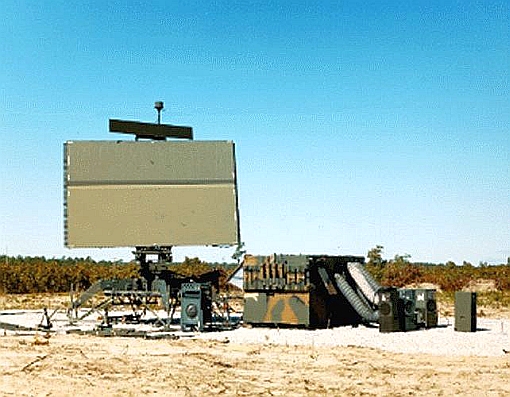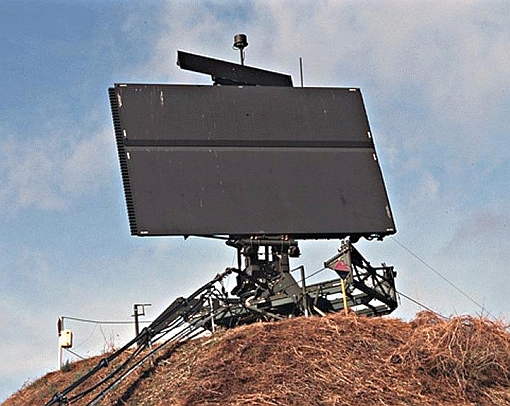The TPS-75 has been the front line US Air Force air defense system standard since 1968. The AN/TPS-75 Radar System ("Tipsy 75") is a mobile, tactical radar system capable of providing radar azimuth, range, height, and Identification Friend or Foe (IFF) information for a 240-nautical-mile area. This deployable/transportable radar system is capable of providing long range radar data to support operations and control of tactical aircraft. The TPS-75 today forms the backbone of the US Air Force Air Defense system. The AN/TPS-75 Radar system provides a "real-time" radar airspace picture and data in support of the battle commander and the Ground Theater Air Control System (GTACS) via radio, telephone, microwave relay, or satellite communications link. The AN/TPS-75 radar system includes the UPX-27 IFF/SIF equipment, Tactical Air Operation Interface Gp OA 9194/TYQ-23(V)2, Modular Control Equipment Interface Group (MIG) and AN/TLQ-32 ARM Decoy.

The AN/TPS-75 is a mobile ground radar set designed to conduct long-range search and altitude-finding operations simultaneously. Data from the AN/TPS-75 can be combined with information from other radar to form an integrated picture of the aerial battlefield for theater commanders. The 729th Air Control Squadron, Hill AFB, Utah, uses this radar for a variety of missions. The self-contained data gathering system operates independent of inclement weather and jamming environments and requires only a 400-Hz power source to operate.
The system weighs about 8,400 pounds. It may be transported via plane, helicopter or truck. This includes Air Force C-141 Starlifter, C-5 Galaxy, C-17 Globemaster III or C-130 Hercules aircraft. During daylight hours, a trained six-person crew can assemble the unit from transport mode to full operation within 90 minutes. A trained crew of nine can accomplish the same task within 2.5 hours at night. Disassembly of the set can be done in the same time. The unit's antenna operates from sea level to 10,000 feet in conditions that include winds up to 52 knots, ice as much as 1.2 radial inches in thickness, and heat up to 120 degrees Fahrenheit with 95 percent humidity.
The AN/TPS-75 is a mobile ground three-dimensional (3-D) radar set designed to conduct long-range search and altitude-finding operations simultaneously. Data from the AN/TPS-75 can be combined with information from other radar to form an integrated picture of the aerial battlefield for theater commanders. The 729th Air Control Squadron, Hill Air Force Base, Utah, uses this radar for a variety of missions. The self-contained data gathering system operates independent of inclement weather and jamming environments and requires only a 400-Hz power source to operate.
The AN/TPS-75 radar system is a mobile, tactical radar system capable of providing radar azimuth, range, height and Identification Friend or Foe information for a 240-nautical-mile area. This deployable/transportable radar system is capable of providing long range radar data to support operations and control of tactical aircraft. The AN/TPS-75 radar system provides a "real- time" radar airspace picture and data in support of the battle commander and the ground theater air control system via radio, telephone, microwave relay, or satellite communications link.
The AN/TPS-75 radar system is transportable by Air, Land or Sea. Specifically: truck, helicopter, cargo aircraft and dolly sets (M-832). The Government anticipates awarding a contract in 1998 for the engineering and design phase of the program with options for a production run of a minimum of two (2) and an approximate total of 20 to 60 shelters. Estimated quantities are 3 to 15 shelters per year over a five year period. The shelters will be based on a design similar to the current S-280C/G construction, but designed to accommodate the Radar System Shelter Replacement (RSSR) dimensions and the weight requirements. The shelters are intended to be a direct replacement for the existing shelters currently housing the AN/TPS-75 radar system without changes to: the interface with or layout of the system equipment, internal and external shelter dimensions, or the current maintenance concept. The exterior dimensions will be 84 inches high, by 87 inches wide, by 177 inches long. The interior dimensions will be 74.5 inches high, by 81.5 inches wide, by 168.0 inches long. The tare weight will not exceed 2000 pounds and the payload will not be less than 8500 pounds. The unmodified shelter will have 60dB of Electro-Magnetic Interference shielding effectiveness.
The Microwave silicon carbide (SiC) High-Power Amplifiers Defense Technology Objective was to develop compact, lightweight, highly effective L- through X-band microwave solid-state transmitter building blocks for potential use in high-performance radar, communications, and EW systems. This DTO directly supported the Air Force's AN/TPS-75 ground-based radar transmitter upgrade, impacts A rmy Patriot, groundbased radar, and theater high-altitude air defense systems, and affects ground-based, shipborne, and airborne surveillance, fire control radars, and EW jammer equipment.
Completed in 1999, this DTO significantly improved the technology of SiC transistors for application in advanced microwave high-power amplifiers. Pulsed 3 GHz SiC static induction transistors were improved from the 75-watt range to over 300 watts. SiC metal-semiconductor field-effect transistors (MESFETs) for CW operation at 10 GHz were improved from the 1-watt level to around 10 watts. The process capability for these devices was improved, resulting in a demonstrated epitaxy layer uniformity of 5%, as well as the first commercial release of an SiC radio frequency (RF) power transistor in July 1999. The impact of this technology is a 2-5x improvement in the power per device and an increase in operating temperature range from 125oC to 250oC. The resulting 2-5x decrease in the size and weight of RF power amplifiers provides the warfighter with improved mobility and reliability in a multitude of radar, communications, and EW systems. This DTO was sponsored by the Air Force, Navy, and DAR PA, with tri-Service participation. Potential system insertions include the Air Force TPS-75 S-band radar upgrade, towed decoys such as ALE-50, and multifunction active arrays for the Navy's SC-21 platforms.
The GTACS, the ground based portion of the Theater Air Control System (TACS), consists of a family of communications-electronics components that provide the battlefield commander with systems and resources to support situational awareness, joint, allied, and combined forces planning, execution of the air tasking order, all interdiction, close air support, counter air, airlift, air refueling, special operation, electronic combat, surveillance, reconnaissance, and search and rescue missions. The GTACS uses as its primary sensor the AN/TPS-75 radar, a mobile, three dimensional (range, azimuth, altitude) surveillance, acquisition, and tracking radar which enables aerospace control in the theater of air operations.
AN/TPS-75 Radar Shelter Replacement FY00/01 funds provide for procurement of the radar shelter modification which replaces 20-year-old shelters (which are deteriorated, corroded, costly to operate/maintain and mission limiting) with an improved version possessing an increased weight capability to handle weight growth already incurred. Increasing maintenance costs and mission limiting assets in the field are driving this modification.
Antenna Bearing Redesign FY99-01 funds provide for procurement and installation of the modification that replaces the current AN/TPS-75 radar antenna rotational and stationary pedestal system and the antenna bearing with a more robust, reliable design. The current bearing is unable to withstand the axial and radial shock loads experienced in a tactical environment. Engineering analysis shows that the current design experiences degradation in bearing life with wind loads over 31 knots. This presents a safety of equipment hazard since the technical order requires the bearings to withstand winds over 50 knots. The current design cannot meet operational mission requirement and/or is mission-limiting. The new design will provide two to three times more operational life.
AN/TPS-75 FY99/00 funding provided for the correction of deficiencies to the radar's frequency stability, section speed and noise, transmitter failures and power deficiencies. Lack of funding will degrade target identification capabilities for the Expert Missile Tracker and will increase critical failures due to parts obsolescence precluding necessary readiness of the radar and the GTACS system. FY01 funding was required for remaining kits and equipment improvement installations.
In September 2004 Raytheon was selected by the U.S. Air Force to upgrade AN/TPS-75 radars for Hill Air Force Base, Utah. The five-year indefinite-delivery indefinite-quantity contract has a ceiling of $13 million, including the three-year base period and one two-year option. Under the contract, Raytheon Technical Services Company LLC (RTSC) will design, develop, test and produce upgraded replacements for AN/TPS-75 subassemblies to increase reliability, reduce maintenance cost and eliminate obsolescence issues. Raytheon's involvement with the AN/TPS-75 began in 1997 when Hill Air Force Base selected the company to analyze and propose solutions to system obsolescence issues.
Tobyhanna Army Depot's AN/TPS-75 Radar System was the recipient of the 2006 Shingo Prize for Excellence in Manufacturing - Bronze Level, Public Sector. The AN/TPS-75 Radar System was taking up to 12 months to overhaul. The impact was an increase to our customer wait time for the system to be returned. A team was formed to conduct lean rapid improvement events of maintenance processes for the system's wave guides, rotary couplers, shelter reassembly and antenna parts. Visual management aids were introduced into the rotary coupler repair area to identify the most efficient layouts and establish places to put things where they would be most beneficial, such as tool boxes, parts bins, and work benches. Production control boards highlighted expected performance parameters along with key dates for overhaul deadlines. The boards allowed personnel easy access to track key events in the process to maintain focus on the entire TPS-75 overhaul mission. These and other lean techniques have improved the repair cycle time from 12 months to under 7 months.

The AN/TPS-75 transmitter modulator is a high failure system and contains two single points of failure. Current plans call for replacing the current tube-driven modulator with a solid state system. This will replace the Trigger Amplifier, the Shunt Regulator, the Pulse Forming Network, the SF6 Tank, the Focus Coil Power Supply and the Diode Stack.
Specifications
| Weight | shelter - app. 8,400 pounds antenna - app. 7,400 pounds |
| Pulse Repetition Frequency (PRF) | 235, 250, 275 +/- 0.5 Hz fixed, and two selectable average PRFs; 250 and 275 staggered. For each staggered selection, the transmitter operates sequentially on one of seven PRFs. |
| Transmitter Characteristics | peak power - 2.8 MW nominal verage power - 4.7 kW nominal pulse width - 6.8 +/- 0.25 microseconds |
| Receiver Characteristics | type -seven logarithmic channels sensitivity - negative 105 dB mds dynamic range - 70 dB search, 70 dB height intermediate frequency - 32 MHz |
| 3-D Coverage (Search, Height and Range) | azimuth - 360 degrees (operator controlled blanking optional) elevation angles - 0.5 to 20 degrees above the radar horizon maximum altitude - 95,500 feet range - one to 240 nautical miles scanning rate - approximately 6.5 rpm |
| Dimensions | 11 feet high by 18 feet 4 inches wide |
| Polarization | vertical beam width - 1.1 degrees horizontal and 1.55 degrees to 8.1 degrees with a total of 20 degrees (6 stacked beams) |
No comments:
Post a Comment